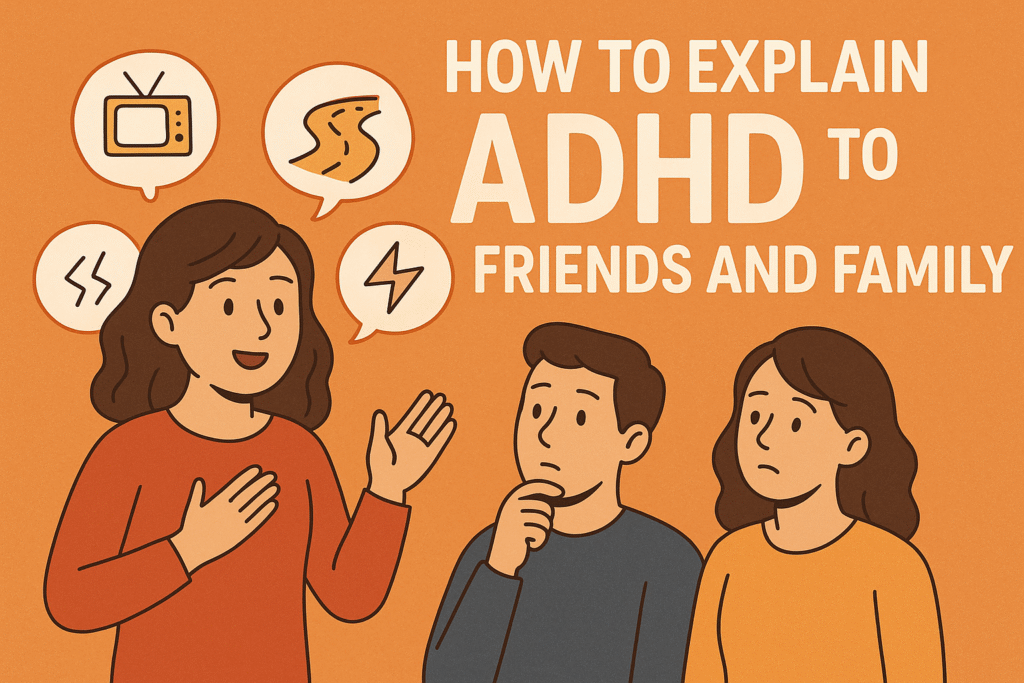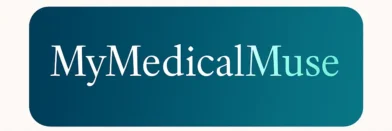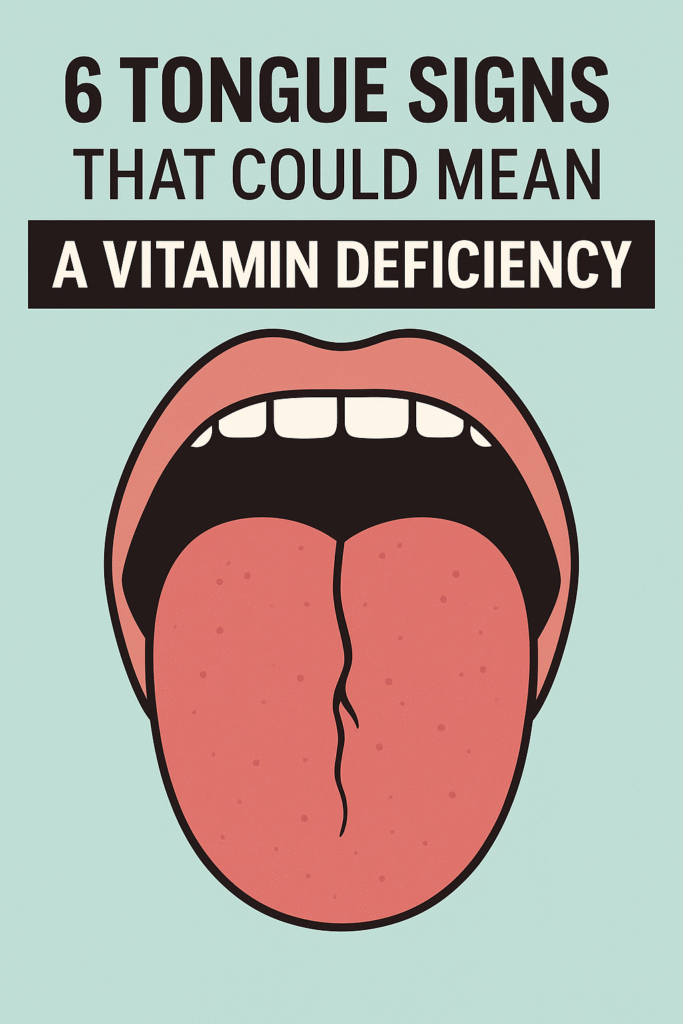
⚠️ Affiliate Disclaimer: This post may contain affiliate links, which means I may earn a small commission — at no extra cost to you — if you make a purchase through one of these links. I only recommend products or services I genuinely trust and believe can provide value. Thank you for supporting My Medical Muse!
How to Explain ADHD to Friends and Family: 10 Powerful Steps for Understanding
How to Explain ADHD to Friends and Family
Attention Deficit Hyperactivity Disorder (ADHD) is one of the most commonly discussed neurodevelopmental conditions, yet it remains one of the most misunderstood. For many people living with ADHD, the challenge is not only in managing the symptoms themselves but also in explaining the condition to friends, family, and loved ones who may not fully understand it. Misconceptions, stereotypes, and stigma can make open conversations difficult.
This guide will help you understand how to explain ADHD to friends and family in a way that is clear, compassionate, and relatable. Whether you are an adult with ADHD, a parent of a child who has been diagnosed, or simply someone wanting to advocate for better understanding, these insights will equip you to build bridges of empathy and support.
What Is ADHD? Starting with the Basics
Before explaining ADHD to friends or family, it’s important to ground the conversation in accurate, accessible information.
ADHD is a neurodevelopmental disorder that affects brain functioning, particularly in the areas of attention, executive function, and self-regulation. It is not about laziness, lack of intelligence, or poor parenting, rather, it’s a condition that shapes how a person thinks, processes information, and responds to their environment.
Key features of ADHD include:
- Inattention: Difficulty sustaining focus, following through on tasks, or organizing activities.
- Hyperactivity: Restlessness, difficulty sitting still, or feeling driven by an internal motor (though not everyone with ADHD is hyperactive).
- Impulsivity: Acting quickly without thinking through consequences, interrupting conversations, or making hasty decisions.
ADHD exists in different types: predominantly inattentive, predominantly hyperactive-impulsive, and combined type. Each person’s experience of ADHD is unique, which is why it’s called a spectrum condition.
Also Read: Everything You Need To Know About Autism
Why It’s Hard to Explain ADHD to Others
Explaining ADHD to friends and family can be one of the biggest hurdles people with the condition face. The challenge often lies in the gap between lived experience and public perception. While ADHD is a well-researched medical condition, it is still surrounded by myths and stereotypes that can overshadow the truth.
Some of the most common misconceptions include:
- “Everyone gets distracted sometimes.”
- “ADHD is just an excuse for being lazy.”
- “Children grow out of it.”
- “It only affects boys.”
At first glance, these statements may sound harmless, but they can be deeply invalidating. For someone living with ADHD, the condition goes far beyond occasional distraction or restlessness. It affects daily functioning, emotions, relationships, and self–esteem. When loved ones dismiss ADHD as a quirk or personal flaw, it minimizes the very real struggles involved.
Imagine trying to describe why remembering to pay bills feels overwhelming, why conversations get interrupted unintentionally, or why emotions sometimes feel like tidal waves. To a person without ADHD, these struggles might appear as carelessness or lack of discipline. To the person with ADHD, it’s not a matter of willpower but of neurological wiring. That’s why explaining ADHD can feel like speaking an entirely different language.
The key is to explain it in a way that not only shares facts but also fosters empathy and understanding.
1. Know Your Audience
Not everyone needs the same explanation. How you describe ADHD will depend on who you’re talking to and what matters most to them:
- Parents may want to know how ADHD affects learning, behavior at school, and home routines. Explaining how ADHD influences focus and self-regulation can help them see that challenges are not about defiance but about brain processing differences.
- Siblings might worry that ADHD leads to “special treatment” or unfair attention. They need reassurance that support is not favoritism but a way to help balance the playing field.
- Friends may struggle to understand social difficulties, forgetfulness, or impulsivity. They’ll benefit from hearing how ADHD shapes your behavior in relationships and how it doesn’t diminish your care for them.
- Partners often want to know how ADHD impacts intimacy, shared responsibilities, and emotional regulation. Explaining this openly can prevent misunderstandings and build stronger teamwork in the relationship.
By tailoring your explanation to the person you’re speaking with, you increase the chances of being understood and supported.
2. Use Relatable Analogies
ADHD is an internal condition, you can’t see it like a broken arm or a rash. That invisibility makes it harder to explain, analogies bridge that gap by turning abstract concepts into something tangible and familiar. Here are some of the most effective ones:
- The TV Analogy
Living with ADHD can feel like having dozens of TV channels playing in your head at the same time. Each channel is broadcasting something different, memories, ideas, distractions, emotions and your brain struggles to stay tuned to just one. Sometimes, the remote control that should let you focus on a single channel just doesn’t respond. This helps others understand why sustained attention can feel nearly impossible. - The Traffic Analogy
Picture a busy intersection in a neurotypical brain, the traffic lights control the flow of cars, ensuring order and smooth movement. In an ADHD brain, the traffic lights malfunction, some cars speed through unchecked, others slam on the brakes suddenly, and traffic jams appear out of nowhere. This represents the chaos of thoughts, impulses, and emotions trying to move at once, with little regulation. - The Energy Meter Analogy
Many people with ADHD describe their energy as swinging between extremes. Imagine an energy meter that jumps from “full throttle” to “empty battery” with little warning. There’s often no steady middle ground. This explains why someone might hyperfocus on a project for hours, then struggle to muster the energy to complete simple tasks like doing the dishes or answering a text message.
These analogies make ADHD’s invisible challenges visible, giving your friends and family a mental image they can hold onto. When people can “picture it,” they are far more likely to understand it.
3. Explain What ADHD Is Not
Sometimes, the easiest way to build understanding is by starting with what ADHD is not. Misconceptions spread quickly, and many people base their opinions on stereotypes rather than science. By clearing up myths, you remove barriers to empathy and open the door to accurate understanding.
Here are some common misunderstandings to address directly:
- ADHD is not laziness. People with ADHD often work harder than others just to meet basic expectations. Struggling with focus, organization, or follow-through is not the same as lacking motivation.
- ADHD is not caused by bad parenting. While structure, support, and positive reinforcement matter, ADHD is rooted in brain development and genetics. Parents don’t cause ADHD any more than they cause nearsightedness or asthma.
- ADHD is not just about being “hyper.” Some people with ADHD are constantly active and restless, but many are primarily inattentive. Daydreaming, forgetfulness, or difficulty finishing tasks are just as much a part of ADHD as visible hyperactivity.
- ADHD is not from eating too much sugar. Diet can influence energy and mood, but it does not cause ADHD. Blaming sugar oversimplifies a complex neurological condition.
- ADHD is not something people simply grow out of. While symptoms may shift over time, ADHD often persists into adulthood. Many adults continue to experience challenges with focus, time management, and emotional regulation.
By naming what ADHD is not, you dismantle stigma and make space for a clearer, more compassionate understanding of what ADHD truly is.
4. Share the Science in Simple Terms
Once myths are cleared away, you can share the science without overwhelming people with jargon. Most loved ones don’t need a neuroscience lecture, they need simple, digestible information that affirms ADHD is real, biological, and valid.
Here are some easy-to-share points:
- Brain chemistry: ADHD involves differences in how the brain regulates dopamine, a neurotransmitter linked to motivation, reward, and focus. This makes tasks that feel easy for others like starting homework, replying to emails, or remembering appointments, much harder.
- Brain structure: Research shows subtle differences in certain brain regions, particularly those linked to executive function. This affects working memory, impulse control, organization, and emotional regulation.
- Genetics: ADHD is highly heritable. If one family member has ADHD, it’s common to find it in parents, siblings, or extended relatives. This shows it is a neurological trait, not a character flaw.
Keeping the science simple helps others appreciate that ADHD is not just a matter of willpower. It’s a condition shaped by brain wiring, real, measurable, and deserving of support.
5. Talk About Strengths as Well as Challenges
When explaining ADHD, it’s easy to focus only on the struggles, but doing so paints an incomplete picture. ADHD is not just about deficits, it also comes with unique strengths. Highlighting these can help friends and family see the full humanity of people with ADHD.
Many individuals with ADHD are:
- Creative thinkers. Their ability to connect seemingly unrelated ideas often sparks innovation.
- Energetic and passionate. When engaged, they can bring remarkable focus, enthusiasm, and drive.
- Strong problem-solvers. Thinking outside the box comes naturally, making them resourceful in unconventional situations.
- Resilient. Living with ADHD often means overcoming obstacles daily, which builds determination and adaptability.
By balancing challenges with strengths, you prevent ADHD from being seen only as a disability. Instead, it becomes clear that ADHD shapes both struggles and talents. This more nuanced view invites respect, not pity.
6. Be Honest About Daily Realities
Facts and strengths matter, but personal stories often leave the deepest impact. Sharing how ADHD shows up in daily life makes the condition real and relatable for others.
For example, you might say:
- I sometimes forget appointments even when they’re important to me, it’s not because I don’t care, but because my brain struggles with working memory.
- I want a tidy space, but organizing feels overwhelming. What looks like procrastination is actually paralysis.
- I can hyperfocus on a project for hours, losing track of meals or time but then I can’t seem to finish something as small as a load of laundry.”
- Noisy, busy environments can feel like an assault on my senses. I need breaks to reset, even if I look fine on the outside.
These examples humanize ADHD. They help friends and family move beyond textbook definitions and understand the lived experience.
7. Encourage Questions and Curiosity
Explaining ADHD works best as a conversation, not a lecture. Encourage loved ones to ask questions even if they’re unsure how to phrase them. This shows that curiosity is welcome and helps remove defensiveness.
You can make it easier by saying things like:
- I know this might be new for you, so feel free to ask me anything.
- It’s okay if you don’t fully understand yet, just being open to learning is really helpful.
By inviting dialogue, you create a safe space where misunderstandings can be gently corrected and empathy can grow.
8. Discuss How They Can Support You
Explaining ADHD isn’t just about describing symptoms it’s also about showing loved ones how they can play a supportive role. Support doesn’t mean taking over responsibilities or lowering expectations. Instead, it’s about creating an environment where success feels achievable and relationships stay strong.
Here are some practical ways friends and family can help:
With parents: Patience is key, ADHD can make homework time long and frustrating, so encouragement goes further than criticism. Visual reminders like charts, calendars, or sticky notes help with organization. Celebrating small wins, such as completing an assignment or following a routine, boosts confidence and motivation.
With siblings: Gentle understanding can prevent resentment. Avoid teasing about forgetfulness or impulsivity, it may seem harmless, but it can hurt deeply. Respect the need for quiet breaks or alone time, especially when overstimulation hits.
With friends: Flexibility is invaluable, Sometimes ADHD means forgetting plans or needing to cancel last-minute due to overwhelm. Understanding that this isn’t about lack of care helps friendships last. Friends who can redirect conversations when you get distracted or who remind you gently of plans are especially supportive.
With partners: Relationships often feel the impact of ADHD most directly. Sharing household responsibilities fairly, using reminders or shared calendars, and approaching emotional ups and downs with patience can make a big difference. Couples can work as a team to manage ADHD together instead of falling into blame or frustration.
Ultimately, support is not about fixing someone with ADHD. It’s about working with them, building an environment where they can thrive and where relationships stay rooted in respect and understanding.
9. Normalize Ongoing Conversations
Explaining ADHD is not a single talk you check off your list. It’s an ongoing conversation that grows as you do. Over time, your self-awareness may deepen, or new challenges may arise in school, work, or relationships. Each stage provides another opportunity to talk about ADHD openly.
Normalize the idea that questions, mistakes, and even misunderstandings are part of the process. Remind your friends and family:
It’s okay if you don’t get it all right away.”
We’ll keep learning together.
This mindset takes the pressure off everyone and encourages continued empathy and curiosity.
Handling Common Reactions
When you talk about ADHD, not everyone will respond the same way. Some may be supportive right away, while others need time or reassurance. Here’s how to handle common reactions with clarity and confidence:
Skepticism: “I think everyone has a little ADHD.”
Response: “It’s true that everyone gets distracted sometimes. The difference is that ADHD distraction is more intense, more frequent, and impacts daily life in ways that go beyond what most people experience.”
Minimization: “You’re just making excuses.”
Response: “I get why it might seem like that. But ADHD explains consistent patterns in how my brain works, it’s not about avoiding responsibility. In fact, knowing I have ADHD helps me find tools to improve.”
Over-Sympathy: “That must be awful for you.”
Response: “It definitely comes with challenges, but it also brings strengths like creativity and resilience. What I need most is understanding, not pity.”
Supportiveness: “How can I help?”
Response: “That means a lot. Small things help most like patience if I forget something, reminders when I get sidetracked, or breaking big tasks down into smaller steps.”
By anticipating these reactions, you’ll feel more confident and prepared when explaining ADHD to others.
Tips for Parents Explaining a Child’s ADHD
If you’re a parent explaining your child’s ADHD to grandparents, aunts, uncles, or family friends, you play a key role in shaping how others see your child. The way you frame ADHD can either build compassion or unintentionally reinforce stigma.
Here are some tips:
Focus on both strengths and challenges. Instead of only talking about what your child struggles with, highlight what they excel at whether it’s creativity, problem-solving, or energy.
Explain that support is not “special treatment.” Extra help with homework, flexible routines, or patient redirection aren’t about lowering standards. They’re about giving your child the tools they need to succeed.
Emphasize that ADHD is lifelong, but manageable with the right combination of structure, encouragement, and (sometimes) professional treatment, children with ADHD can grow into successful, confident adults.
Balance discipline with understanding. Boundaries, consistency, and consequences matter but they need to be paired with compassion and realistic expectations. Harsh punishment for ADHD-related struggles often backfires, while positive reinforcement builds progress.
When extended family understands this, they’re more likely to become allies rather than critics, helping your child feel supported, not singled out.
Tips for Adults Explaining Their Own ADHD
As an adult with ADHD, you may feel embarrassed or misunderstood. Remember:
- Be open about your coping strategies (planners, timers, therapy).
- Explain that ADHD affects work, relationships, and routines, but not your intelligence or worth.
- Ask for flexibility and patience, not lowered expectations.
- Share that treatment can include therapy, medication, and lifestyle adjustments.
Building Empathy Through Storytelling
One of the most powerful ways to explain ADHD is through stories. For example:
- “I once forgot a close friend’s birthday. I felt terrible, because I care deeply. My ADHD makes remembering dates hard, but it doesn’t mean you’re not important to me.”
- “I hyperfocused on a project and skipped meals. It wasn’t that I didn’t care about my health, it’s that I lost track of time completely.”
Stories invite compassion by putting ADHD into real-life context.
When Loved Ones Don’t Understand
Not everyone will “get it” right away. Some may never fully understand, that’s okay. Focus your energy on those willing to learn and support you. Use boundaries if necessary, protect your mental health by limiting negative or invalidating conversations.
Final Thoughts
Explaining ADHD to friends and family is an ongoing journey. It requires patience, vulnerability, and persistence. By combining clear information, relatable analogies, personal stories, and practical guidance, you can help your loved ones see ADHD not as a flaw, but as a different way of experiencing the world.
The ultimate goal is not just awareness but empathy and support. When friends and family understand ADHD, they can become allies in your journey, helping you embrace your strengths, navigate challenges, and thrive.
👩⚕️ Need Personalized Health Advice?
Get expert guidance tailored to your unique health concerns through MuseCare Consult. Our licensed doctors are here to help you understand your symptoms, medications, and lab results—confidentially and affordably.
👉 Book a MuseCare Consult NowRelated Blog Post You Might Like:
- 10 Powerful Ways to Support a Partner with Autism in Everyday Life
- How Autism in Women Is Different from Men: 10 Powerful Insights
- Autism and Burnout: 7 Powerful Reasons Why It Hits Harder
- Why ADHD Is Often Misdiagnosed as Depression: 7 Powerful Differences You Must Know
- 7 Proven Ways ADHD Affects Sleep and Productivity (And How to Fix It)


